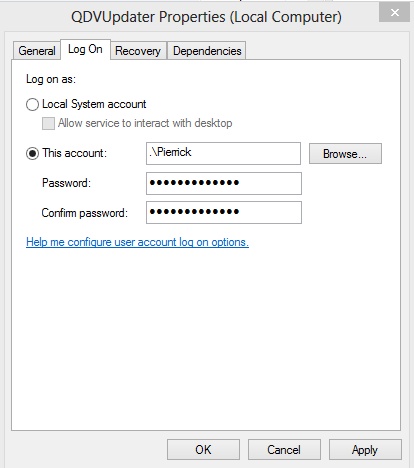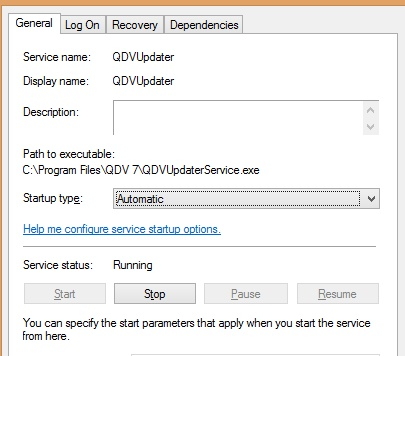Use Case
When a user who is not an administrator updates QDV7, the User Account Control prompts him/her for high rights so that it can install files to the Program Files folder and shortcuts in the Start menu or on the desktop, and can access the Classes_Root section of the registry.
To prevent the users from writing to the Program Files folder, the administrator must consider letting a service run automatically under high rights.
Activating the Service
The service is named QDVUpdater. It is installed when you run the setup program, but is not activated automatically; if you upgrade without the setup program (by the upgrade process through the web site), the service won't be installed.
1.Run <installation directory>/Install_Updater_Service.cmd with administrator's rights
2.Run services.msc and select QDVUpgrader
3.In the Log On tab, give the service administrator's rights
4.In the General tab, select Automatic as Startup type


Parameters
To provide parameters, create a file named Updater_Service_Settings.inf and install it in the installation directory (C:\Program Files\QDV 7). This file is not mandatory and no statement in this file is mandatory.
It can contain several statements:
▪Port= communication port which the service uses to listen to the client (default value: 8022)
▪IgnoreShortcuts= if YES, the shortcuts on desktop and Start menu are not created *
▪IgnoreRegistry=if YES, there is no attempt to write to the registry's HKEY_CLASSES_ROOT section. Usually only a true administrator is allowed to write. To prevent the system from issuing an error message, the others should consider this parameter *
▪IgnoreNGEN=if YES, there is no attempt to run NGEN (used to compile the .NET program to native code targeting your processor). This generally results in faster startup and opening of functions when you open them for the first time in a session. NGEN is not needed and you can save up to 2 minutes at update time when you don’t run NGEN
* Usually shortcuts/associations are not requested for updates because they are created by the Setup program. But, more of them may be needed in the future; when you deactivate the parameter, you won’t benefit from the potential new shortcuts/associations
Example:
Port=8081
IgnoreShortcuts=YES
IgnoreRegistry=YES
IgnoreNGEN=YES
NOTE Port 8081 is less subject to blockage than 8022 (default value)
To take the change into account, restart the QDVUpdater and the QDVUpdateUpdater services.